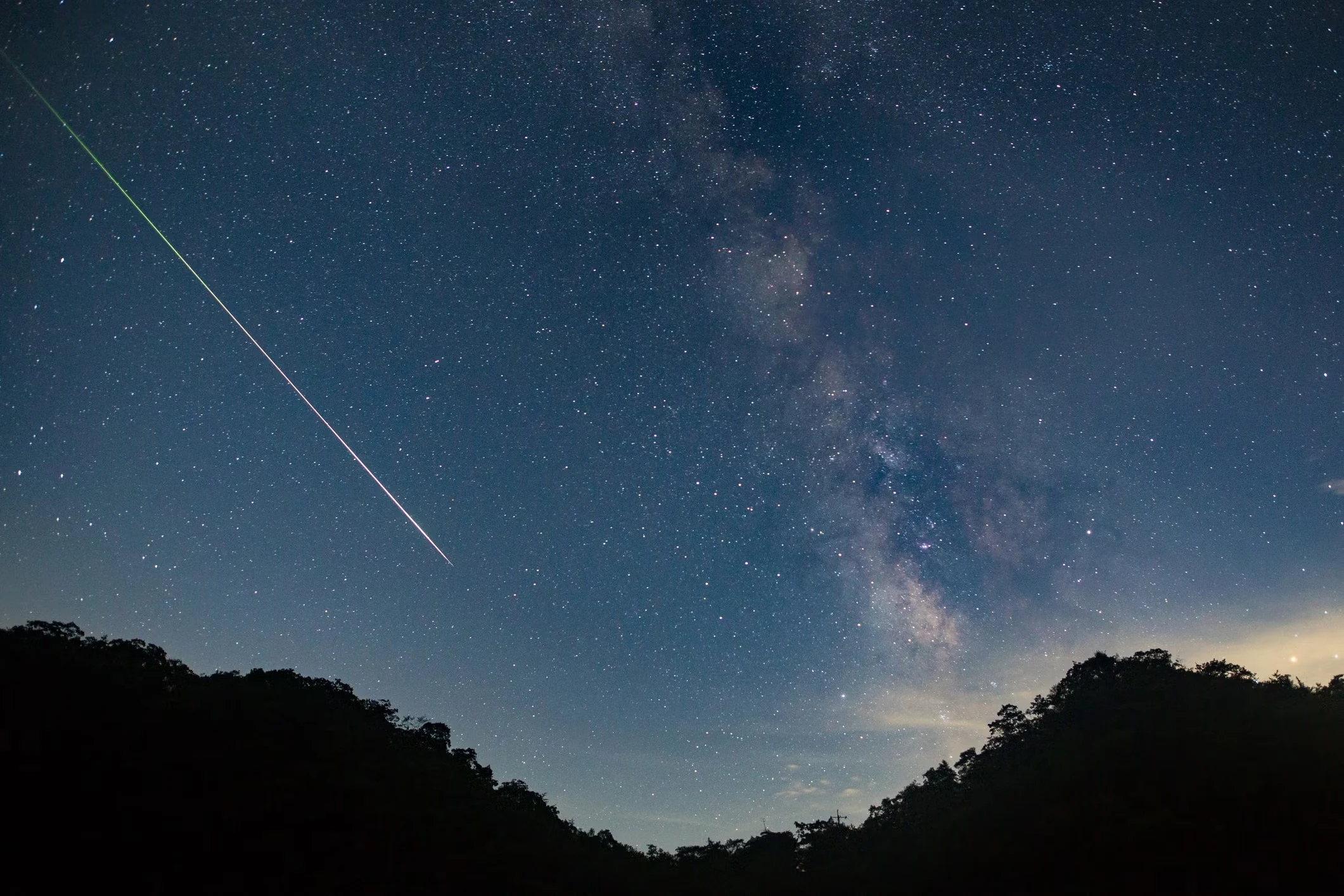Imagine this: As a clear October night is about to end, slowly burning meteors appear in the upper sky, their trails resembling small glowing pieces of metal. It is the beauty of the Draconid meteor shower, a temporary phenomenon that changes the most common nights into memorable wild adventures under the starry sky. People from across the U.S.A., from as near as New York to as far as the desert in Arizona, will be able to see the Draconids without having to stay awake all night, unlike most meteor showers, which usually require it. However, due to their sudden increases and their association with a moving comet, the Draconid showers always keep scientists and hobbyists so interested that they return the following year. If you are willing to catch shooting stars, why not go through this guide that explains the Draconids, their origin and history, and how to watch them in the U.S.?
What Are Draconid Meteor Showers and How Do They Form
It is fascinating how the very essence of Draconid meteor showers is to buzz through particles from outer space, brightening the Earth’s atmosphere and giving people the sight of falling stars. In contrast to shooting stars that are actually stars far away, these small pieces of the cometary tail made of dust and ice, which do not exceed the size of sand grains, are of a completely different nature. When Earth plows through this debris trail, the particles burn up high in the sky, producing bright trails we call meteors.
The Draconids get their name from the constellation Draco the Dragon, a serpentine figure coiled around the north celestial pole. Meteors appear to radiate from Draco’s head, making it seem like the dragon is unleashing a fiery barrage. What sets the Draconids apart? Their meteors are notoriously slow, zipping at just 15-27 miles per second, about half the speed of most other showers. This leisurely pace lets you track them easily, turning each sighting into a deliberate, almost meditative moment.
The Science Behind the Show
- Parent Comet: Every Draconid traces back to Comet 21P/Giacobini-Zinner, a periodic comet that orbits the Sun every 6.6 years. Discovered in 1900 by Michel Giacobini and Ernst Zinner, it sheds debris during its close solar passes, forming the stream Earth crosses in October.
- Debris Dynamics: The comet’s trail is narrow and concentrated, unlike the broader streams of other showers. This can lead to quiet nights or explosive storms when alignments are just correct.
- Atmospheric Burn: Meteors vaporize at 50-75 miles up, glowing from friction with air molecules; no risk of reaching the ground, just pure sky theater.
This unique setup makes Draconid meteor showers a favorite for science buffs, blending predictable astronomy with the thrill of the unknown.
The Thrilling History of Draconid Meteor Showers
Draconids were not merely a modern miracle; their story is full of wonder and unexpected events for centuries. They were first confirmed in the early 1900s, and since then, they have been known for their theatrical behavior. Usually, they are quiet and calm, but once in a while, i.e., every several decades, they go off with “meteor storms” making such a huge “shoot-file” of sky that many people who have seen this event can hardly say a word.
It was 1933 that the golden period began; up to 5,000 meteors per hour lit up the night skies over Europe. Sky was depicted by those who saw it as a “continuous sheet of fire,” with light traces so tightly packed that they mingled, like a waterfall of stars. Another storm followed in 1946, only 13 years later, with a climax of thousands per hour and visibility across different continents. These events coincided with the comet’s recent perihelion, its closest approach to the Sun, when it released fresh debris that Earth plowed through head-on.
More recently, the Draconids have teased us with more minor outbursts. In 2011, European skywatchers tallied over 600 meteors per hour despite moonlight interference. Radar observations in 2012 detected faint signatures from around 1,000 meteors, suggesting the shower was more active than previously observed. The years 1985, 1998, and 2018 were particularly notable for the Eta Aquarids, which showed abrupt increases in intensity, although no full-strength storms occurred. The past is littered with such tricky moments for meteor watchers, and the next big event could be just around the corner. In fact, these events imply that an American watching the night sky on a supposedly quiet night in their own backyard might be witnessing the same celestial wonder thousands of miles away. Just consider how your grandparents may have told you about the spectacle flashing across the sky of a Midwest farm in 1946.
Iconic Draconid Outbursts
- 1933 Storm: Thousands of slow, colorful meteors overwhelmed Europe; a once-in-a-lifetime event tied to the comet’s debris peak.
- 1946 Spectacle: Similar intensity, with reports from the U.S. East Coast; marked the shower’s storm potential.
- 2011 Burst: 600+ per hour in Europe; modern tech like cameras captured vivid footage, inspiring today’s apps and live streams.
These tales fuel the Draconids’ allure, proving they’re not just predictable patterns but living echoes of our solar system’s chaos.
Draconid Meteor Showers in 2025: Expectations and Peak Dates
Fast-forward to 2025: The Draconids are active from October 6 to 10, with peak activity hitting on the evening of October 8 into early October 9. Under ideal conditions, expect 5-10 meteors per hour, but this year’s setup teases more. Comet 21P/Giacobini-Zinner reached perihelion in March 2025, shedding fresh debris that could spark an outburst, potentially hundreds per hour if alignments favor us. NASA even calls it a “significant” possibility, though the waning gibbous moon (post-Harvest Supermoon on October 6) might wash out fainter streaks.
For U.S. viewers, timing is golden: The radiant rises early, so prime viewing starts right after sunset, around 7-8 PM local time, and lasts until 10 PM or so—no need for all-nighters like with other showers, this one’s tailor-made for family evenings. Weather-wise, the Central U.S. and Southwest promise clearer skies on peak night, while the Southeast battles clouds from an incoming nor’easter. If clouds roll in, apps like Stellarium can simulate the show.
The unpredictability? That’s the hook. Will 2025 join the Storm Hall of Fame, or deliver a subtle sparkle? Either way, it’s a low-stakes thrill that keeps you glancing skyward.
How to Watch Draconid Meteor Showers Like a Pro
Catching Draconids doesn’t require fancy gear, just patience, a dark spot, and clear eyes. Head out as dusk settles, lie back, and let your vision adjust for 20-30 minutes. No telescopes; they narrow your view. Instead, scan the whole northern sky, where Draco’s head (near bright stars Eltanin and Rastaban) points the way.
Pro tip: Face north, away from the moon’s glow, and use a hill or tree as a natural blocker. In urban areas like Chicago or LA, drive 30-60 minutes to a state park; Bortle Scale 4 or darker skies double your odds. Dress warm, October chills sneak up, and bring a thermos of hot cocoa for comfort.
Essential Viewing Tips for Americans
- Prime Locations: Great Smoky Mountains (East), Badlands National Park (Central), or Joshua Tree (West) for minimal light pollution and epic horizons.
- Timing Hack: Start at twilight; slow meteors are easiest to spot overhead, moving northwest to southeast.
- Moon Mitigation: Block lunar light with terrain; focus on the opposite horizon for contrast.
- Group Fun: Host a star party with blankets and binoculars for non-meteors, and turn it into a neighborhood event.
- Tech Boost: Use the NASA Skywatching app or TimeandDate’s meteor map for real-time radiant tracking.
With these steps, even first-timers can snag 5-10 sightings, building that addictive “just one more” vibe.
Draconid Meteor Showers vs Orionids: Which October Shower Wins
October’s doubleheader pits the quirky Draconids against the reliable Orionids, peaking October 20-21. Both dazzle, but they’re night-and-day rivals. Draconids are the underdog: Evening-friendly, slow, and storm-prone (up to thousands/hour in bursts), but often moon-challenged and modest at 10/hour max. Orionids? The showstopper, fast (41 miles/second), bright fireballs from Halley’s Comet, delivering 15-20/hour under dark new moon skies.
Draconids suit early birds and families; Orionids reward night owls with speed and spectacle. Catch both for a complete October cosmic feast, Draconids for surprise, Orionids for consistency.
Quick Comparison Breakdown
- Speed and Style: Draconids crawl (graceful arcs); Orionids blaze (swift, fiery trails).
- Best Time: Draconids post-sunset; Orionids pre-dawn.
- Moon Impact: 2025 Draconids hindered; Orionids moon-free for max visibility.
- Storm Potential: Draconids win for rarity; Orionids for steady reliability.
No losers here, just complementary thrills to fill your autumn calendar.
Why Draconid Meteor Showers Captivate American Skywatchers
In a nation spanning deserts to mountains, Draconid meteor showers resonate deeply. They’re accessible, require no international travel, and tie into our love of the wild unknown —from Route 66 stargazing to Appalachian folklore about “falling stars.” For kids in Texas or elders in Maine, they’re a free portal to wonder, fostering STEM curiosity amid screen-saturated lives. Plus, with climate shifts altering night skies, these events remind us of timeless beauty.
As 2025 unfolds, the Draconids aren’t just meteors; they’re invitations to unplug, connect, and dream. Whether you spot a handful or a horde, each streak etches a memory.
Your Next Steps to Chase the Draconids
Ready to hunt dragons? Mark October 8 on your calendar, scout a dark-sky spot via DarkSky.org, and share your sightings on community forums. If clouds win, pivot to Orionids or virtual NASA streams. The sky’s always calling, answer it, and let the Draconids light your path to cosmic bliss.





